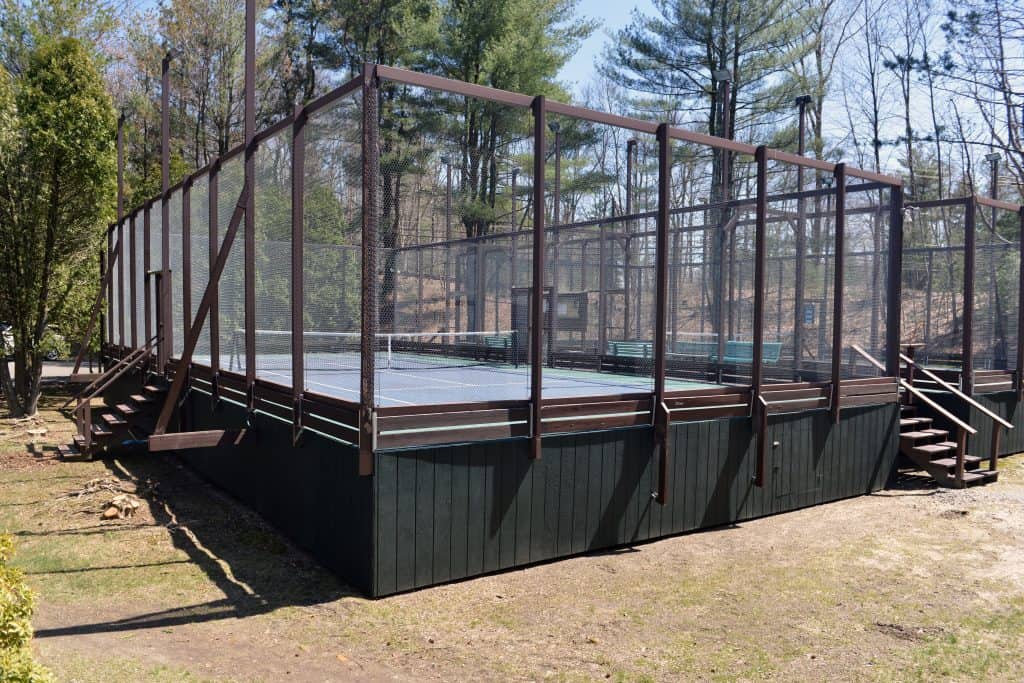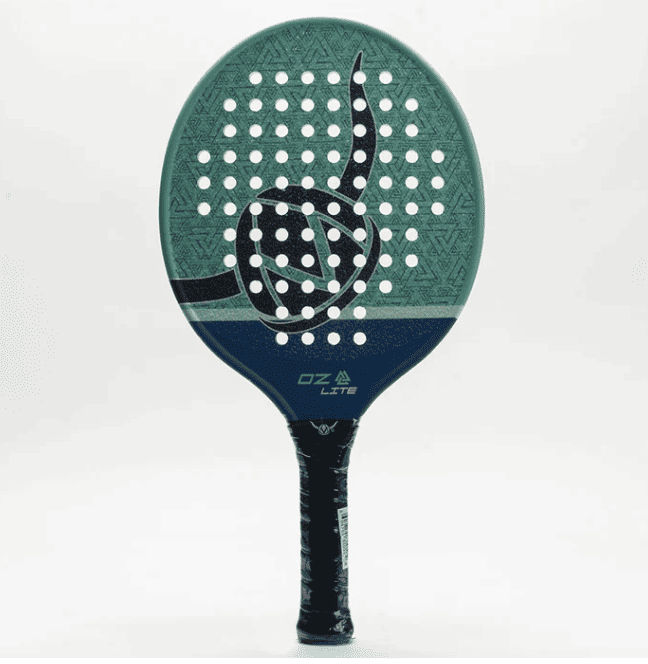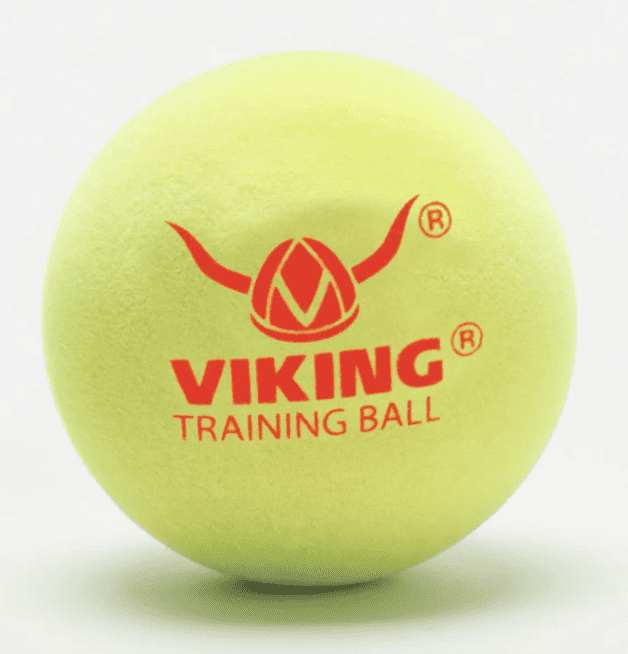Platform tennis, an intriguing combination of tennis and squash, has been quite the racket in the sports world.
But what exactly is it? And why is it rapidly gaining popularity among sports enthusiasts across the globe?
Well, picture this: A brisk winter day, the warmth of a heated court beneath your feet, and a small, spongy ball whizzing back and forth in a high-energy, strategic game.
Welcome to the exhilarating world of platform tennis.
Platform tennis is a unique sport that has been increasing in popularity. It’s a super fun game that combines the finesse of tennis, the swift hand-eye coordination of pickleball, and the strategic play of chess, all within the confines of a compact, elevated court.
In this blog post, we’ll answer the question of what is platform tennis, unpacking its rules, strategies, and why it’s becoming such a popular choice for those seeking a new sporting adventure.
So grab your paddle, and let’s embark on this exciting journey together!
What is Platform Tennis?
Origins of platform tennis
Platform tennis has an interesting origin story. The sport was developed in the late 1920s in Scarsdale, New York. Two neighbors, James Cogswell and Fessenden Blanchard, were on the hunt for a winter sport that could be played outdoors close to home.
They designed the game with unique features like a compact, elevated court, surrounded by wire mesh fencing allowing the ball to remain in play after bouncing off the walls. This made it well-suited to the harsh winter conditions of New York, and the heated courts allowed the game to be played in all weather conditions.
While platform tennis is often associated with paddle tennis, it’s worth noting that paddle tennis (now called Pop Tennis) has its own separate origin. Frank P. Beal, a New York City official, introduced paddle tennis on New York playgrounds in the early 1920s, having invented it as a child in Albion, Michigan.
Over the years, platform tennis has grown in popularity and is now enjoyed by thousands of people around the world. It’s a testament to the ingenuity of its creators and the enduring appeal of this engaging winter sport.
Platform Tennis Court

A platform tennis court is a unique setup that brings an exciting twist to the traditional tennis court. The platform court is significantly smaller, with its dimensions being roughly one-third to one-quarter of a conventional tennis court. Specifically, it measures 44 feet long by 20 feet wide, same as a pickleball court.
One of the most distinctive features of a platform tennis court is the 12-foot high chicken wire fencing that surrounds it. Unlike in traditional tennis and pickleball, the fencing plays an active role in the game–the ball is allowed to hit the fence after bouncing once in play on the ground and can still be returned, adding an extra layer of strategy to the game.
Another unique aspect is the construction of the court itself. Platform tennis courts are generally elevated and built on an aluminum deck. This design enables the court to be heated from beneath, making it possible to play platform tennis in cold weather conditions, even when there’s snow on the ground.
The markings on a platform tennis court are similar to those on a regular tennis court, with service boxes and baselines. However, due to the smaller size of the court, the game tends to be faster-paced and requires quick reflexes and strategic use of the surrounding fence.
Equipment Used
Platform tennis requires specific equipment that is quite distinct from other racquet sports. Here’s a rundown of the main pieces of gear you’ll need:
- Paddle: Unlike tennis which uses a racquet, in platform tennis players use a solid paddle that is typically 18 inches in length. The paddle is perforated and made from a combination of materials, most commonly graphite and titanium.
- Ball: Platform tennis balls are made of rubber and are similar in size to regular tennis balls. However, they have a spongy texture and are often colored yellow or green for visibility. They are designed to bounce less than standard tennis balls, which makes the game more challenging and strategic.
- Shoes: Players typically wear court shoes that provide good grip and stability. It’s crucial to have non-slip footwear due to the fast-paced nature of the game and the potential for slick court conditions, especially in winter.
- Clothing: Comfortable, athletic clothing that allows for freedom of movement is recommended. Given that platform tennis is often played in colder weather, layers are advisable.
- Other Accessories: Some players choose to use gloves for a better grip on the paddle, especially in colder weather. Protective eyewear can also be used for safety.


Remember, the right equipment can make a significant difference in your performance and enjoyment of the game.
Growing Popularity of Platform Tennis
The popularity of platform tennis has been on a steady rise over the past few years, transforming from a niche pastime into a globally recognized sport. The game’s unique blend of strategy, skill, and social interaction has attracted a diverse community of players, making it more than just a sport—it’s a way of life for many.
One of the key factors driving the growth of platform tennis is its accessibility. The sport can be played by individuals of all ages and skill levels, making it an inclusive activity that brings together families, friends, and communities. From kids learning the ropes to seasoned athletes seeking a new challenge, platform tennis caters to everyone.
Winter sports enthusiasts, in particular, have embraced platform tennis. Its heated courts offer a unique opportunity to stay active outdoors even in the chilliest months. This has made the sport especially popular in regions with cold winters, where other outdoor activities may not be feasible.
But what truly sets platform tennis apart is the strong sense of community among its players. Many clubs and leagues across the globe organize regular tournaments, social events, and charity drives, fostering camaraderie and engagement beyond the court. This social aspect of the sport has been instrumental in building a vibrant, growing community of platform tennis enthusiasts.
As the sport continues to gain recognition, the community of platform tennis players is set to expand further. Whether you’re seeking a fun, challenging way to stay fit, or looking to connect with a like-minded community, platform tennis could be your game of choice.
Rules and Gameplay
A brief overview of the basic rules of platform tennis
Platform tennis is a unique sport with its own set of rules. Here’s a basic overview to get you started:
- Court Layout: The game is played on a small, elevated court surrounded by a 12-foot high fence. The court has service boxes and baselines similar to a traditional tennis court.
- Scoring System: The scoring system is the same as in lawn tennis, starting with love (zero), then 15, 30, and 40. However, unlike tennis, there is only one serve allowed, not two.
- Serve: In platform tennis, a serve starts a point. The ball is tossed and hit into the opposite service box. It’s valid even if it touches the net. You only get one chance. There are no “lets”.
- Fence Play: After the ball has been served and returned, it can hit the fence and still be in play, adding an extra layer of strategy to the game.
- Teams: Platform tennis is typically played in doubles.
These are just the basics. For detailed rules, visit the American Platform Tennis Association website or check here.
Scoring System and Match Format
The scoring system in platform tennis follows the traditional tennis format but with a few key differences due to the unique nature of the game. Here’s a brief explanation:
- Point System: The point system starts at “love,” which signifies zero. The first point won is called “15”, the second “30”, and the third “40”. If a player scores a fourth point before their opponent reaches “40”, they win the game.
- Deuce: If both teams reach “40”, this is called a “deuce”. From deuce, a team must win two consecutive points to win the game. The first point won from the deuce gives the team an “advantage”. If the team with the advantage wins the next point, they win the game. If that team loses the next point, the score goes back to deuce.
- Game, Set, Match: A standard match is made up of best-of-three sets. To win a set, a team must win six games by a margin of at least two games. If the set reaches a 6-6 tie, a tie-break is played to decide the winner of the set. The first team to win two sets wins the match.
- Serving: Unlike tennis where each player has two chances to serve correctly, in platform tennis, the server only gets one chance. If the server fails to serve correctly, it results in a point for the opposing team.
Benefits of Playing Platform Tennis
Playing platform tennis offers a variety of benefits, both physical and mental:
- Full Body Workout: The fast-paced nature of the game provides an excellent full-body workout. It engages your arms, legs, and core muscles, enhancing overall fitness and strength.
- Cardiovascular Health: The constant movement and quick reflexes required in platform tennis can significantly improve cardiovascular health and endurance.
- Improved Coordination and Reflexes: The small court size and the need to react quickly to bounced balls off the screen can help enhance hand-eye coordination and sharpen reflexes.
- Stress Relief: Like many sports, playing platform tennis can be a great stress reliever. The focus required during the game can provide a distraction from daily worries and stresses.
- Social Interaction: Platform tennis is typically played in doubles, which encourages teamwork and social interaction. This can lead to improved communication skills and the formation of new friendships.
- Mental Fitness: Navigating the unique challenges of platform tennis requires strategic thinking, which can boost brain health and cognitive abilities.
- Year-Round Play: Thanks to heated courts, platform tennis can be played all year round, making it a great way to stay active even in colder months.
- Suitable for All Ages: The game is suitable for all ages, promoting inclusivity and family-friendly fun.
These benefits make platform tennis more than just a sport. It’s a holistic activity that promotes physical health, mental agility, and social connections.
Getting Started in Platform Tennis
Getting started in platform tennis is a rewarding journey that combines physical activity, strategy, and social interaction. Here are some steps to help you get started:
- Understand the Game: Begin by familiarizing yourself with the rules of platform tennis. Understanding the scoring system, court layout, and basic rules will give you a good foundation.
- Get the Right Equipment: You’ll need a platform tennis paddle and balls. Paddles are solid with perforations, different from traditional tennis racquets. The balls used in platform tennis are spongy and depressurized. Both are typically available at sports equipment stores or online.
- Find a Court: Look for local platform tennis clubs or public courts in your area. Some fitness centers also have platform tennis facilities.
- Take Lessons or Clinics: Many clubs offer beginner lessons or clinics. This can be a great way to learn the basics of the game, including serving, volleying, and using the screens.
- Practice Regularly: Like any sport, regular practice is key. Start by rallying and getting comfortable with the paddle, ball, and unique elements like the screens.
- Play Matches: Once you feel confident with the basics, start playing matches. This will help you understand the flow of the game, develop strategies, and improve your skills.
- Join a League or Club: As you progress, consider joining a league or club. This provides regular play, competition, and a chance to meet other platform tennis enthusiasts.
Frequently Asked Questions
Get answers to a list of the most Frequently Asked Questions.
While people sometimes do refer to it as paddle tennis, it is not the same. Paddle tennis, which is now known as Pop Tennis, is a separate sport with its own unique structure.
Yes! The heated court feature of a platform tennis court make it playable all year round and in fact, most people play it as a winter sport!
Conclusion
In conclusion, platform tennis is a dynamic, engaging, and challenging sport that offers a unique blend of physical activity, strategic thinking, and social interaction. Its distinctive features, such as the enclosed court and the use of screens, set it apart from other racket sports, adding an extra layer of excitement and complexity.
Whether you’re a seasoned tennis player looking for a winter alternative, or someone seeking a new sport to try, platform tennis could be just the ticket. By understanding the rules, mastering the underhand serve, learning to use the screens effectively, and developing your strategic game, you can dive into this fascinating sport and enjoy all the benefits it offers.
Remember, like any sport, platform tennis requires patience, practice, and persistence. Don’t be disheartened by initial challenges. Instead, embrace the learning process and enjoy the journey. Before long, you’ll find yourself immersed in thrilling matches, experiencing the joy of a well-executed shot, and perhaps even making new friends along the way.
So why not give platform tennis a shot? Grab a paddle, step onto the court, and discover the fun and rewards of this unique sport. Happy playing!


